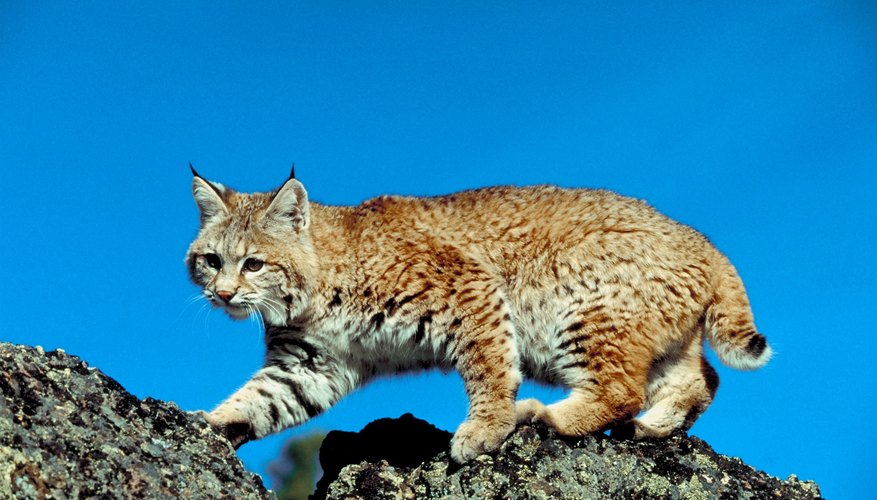
Bobcats are shy, solitary animals that can be active during the day or night, although they prefer dawn, dusk and night hunting. When trapping bobcats, it’s necessary to place trap sets on their travel routes, as they use the same trails and paths consistently and rarely deviate. About two to three times the size of a housecat, bobcats hunt everything from deer to mice, including domestic cats, small dogs and poultry, making them a nuisance at times. Bait for bobcats includes various meats, fresh or slightly tainted for extra scent, herbal oils, bobcat glands and urine and visual flags near the trap. As bobcats are a protected species in some places, check state regulations before you begin.
Meats
Bobcats usually prefer fresh meats such as rabbit, muskrat or poultry. However, they also are known to scavenge so some trappers prefer to age meat before using it as bait, especially in cold weather as the smell carries further. Live birds or rabbits can also be used in certain trap sets. Trappers also make mixes of chunked meat and bobcat scent glands to use as bait. Fish, mice and squirrel also serves as bait. Put chopped fish or mice in a blender, and add a few tablespoons of sodium benzoate as a preservative and a drop of skunk essence for a paste type bait.
Herbal Oils
Bobcats have an acute sense of smell, although they are also visual hunters. Catnip oil can be successfully used to guide bobcats to a trap, since bobcats are as attracted to catnip as housecats. Herbal oils such as sweet musk oil, lovage and asafetida are added to homemade bobcat bait as well. Valerian powder can also be used to add that faint fetid or musky scent that attracts bobcats.
Glands/Urine
When mixing up bobcat bait, trappers use aged bobcat scent glands to attract the cats in a passion bait. An dirt hole trap set can be baited with bobcat gland bait on one side and bobcat urine on another spot to guide the animal to the hole. Even when using a passion bait for a trap, it is necessary to make the entire set look as natural as possible. Bobcats are wary but will usually stop to sniff around a well-set gland and urine combination. Set up a dirt hole set or cubby hole for the cat and use a chunk of beaver as well as the gland and urine combination. Bobcats that aren’t hungry might walk by the cubby but will stop for the musky scent of another animal. Make sure the cubby is large enough for the cat to enter and turn around as they don’t like backing up.
Visual Attractors
Many bobcat trappers swear by adding a visual “flag” above the trap. As bobcats are noted for hunting by sight, they’re attracted to bits of fur or feathers dangling above the trap. Trappers also use aluminum foil, jar lids and fake fur to make the visual flag. Bobcats are inquisitive and will come to check out that flickering bit of fur or foil. Check to see what is legal in your state and region before using bird wings as a visual attractor as it might be illegal.
Writer Bio
Patricia Neill began writing professionally in 2000, spending most of her career as managing editor of “Blake: An Illustrated Quarterly.” Neill published political satire at LewRockwell.com and other libertarian websites. She also has an essay in “National Identification Systems: Essays in Opposition." Neill holds a Bachelor of Arts in English from Nazareth College of Rochester.


